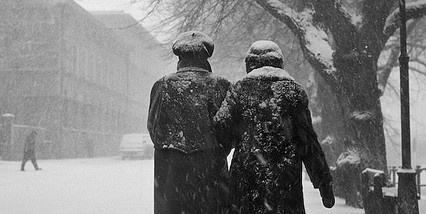What’s winter got to do with politics?
In the 21st century, you might think that the way we live our lives would no longer be determined by anything as primal as the weather. So it might come as a surprise to be reminded that winter – or...
In the 21st century, you might think that the way we live our lives would no longer be determined by anything as primal as the weather. So it might come as a surprise to be reminded that winter – or more specifically cold weather – is directly responsible for the premature deaths of tens of thousands of older people every year.
The most recent figures from the Office of National Statistics (ONS) published last week show that there were 24,000 extra deaths last winter, the majority of these among older people. What the figures don’t show is that for every death, there are many more people who become seriously ill, needing hospital admission in the short-term and possibly social care in the longer-term.
Age UK has published a new report The Cost of Cold which highlights the massive personal and financial cost that results. We carried out new analysis which suggested that the cost to the NHS in England alone of cold homes is likely to be around £1.36bn a year.
The good news is that it doesn’t have to be like this. Winter death rates in many other European countries – and even in Siberia – are much lower. Ironically, it is the temperate Atlantic countries of the UK, Ireland and Portugal which have the highest death rates.
It’s likely that older people in colder countries like Finland and Germany, which have much lower death rates, are much better prepared for winter, and know how to keep themselves warm. We also know that these countries have much better insulated housing stock.
The latest statistics from the ONS also show an encouraging decline in excess winter deaths in England and Wales over the last 50 years. This is likely to reflect improvements in energy efficiency and warmth of the UK’s housing stock over that time.
However, despite those improvements, this country still has some of the worst-insulated housing stock in Europe. There are over half a million older households living in properties which are ‘hard to heat’ – for example with solid walls or no access to mains gas, and an estimated 6 million older people living in fuel poverty.
With rising fuel prices, more and more people are trapped in fuel poverty, unable to afford to heat their homes sufficiently to keep themselves healthy. And with energy costs rising globally, it is hard to see how any approach to tackling fuel price rises will be more than a short term fix.
Ultimately improving the energy efficiency of our housing stock has to be the most cost effective solution. With the average cost of making a home energy efficient around £7,500, and the cost of a week’s stay in hospital for an older person being from £1,750 to £2,100, this is clearly a good investment.
This winter sees the end of the Warm Front programme. Set up in 2000, this scheme provided grants to low income households to install energy efficiency measures. It will be replaced by the new, market-based ‘green deal’, under which households take out a loan to fund energy efficiency improvements, and pay it back over a period of around 25 years out of the savings made.
Recognising that not all households or all properties will be able to fund a loan out of savings made, the green deal will be accompanied by a new energy company obligation (ECO) which will provide funded improvements to low income households or hard to insulate properties. This will be paid for by the energy companies and ultimately by consumers.
But neither of these programmes will deliver energy efficiency improvements on the scale that is needed to really tackle excess winter deaths. Recent research by the Association for the Conservation of Energy has shown that only 100,000 households in fuel poverty – 2.6 per cent of the projected total – are likely to be reached by the new measures.
There is an alternative. From next year, the Treasury will start to receive carbon revenues generated under the EU emission trading scheme (ETS) and the UK carbon price floor mechanism. These will bring in an average of £4bn a year. If this income was used to fund energy efficiency measures it would be enough to lift nine out of 10 households out of fuel poverty. At the same time it would create jobs, cut carbon emissions and, by enabling older people to keep warm in winter, reduce winter deaths and the associated cost to the NHS and adult social care.
The arguments for doing this stack up, and there is growing support on all sides of the House, and from a broad alliance of charities, businesses and unions through the Energy Bill Revolution campaign.
In the end, whether we, as a country, decide to take this step will be a political decision. We cannot control the weather. But whether tens of thousands of older people will still be dying prematurely as a result of winter cold in 10 years’ time is a profoundly political business.
